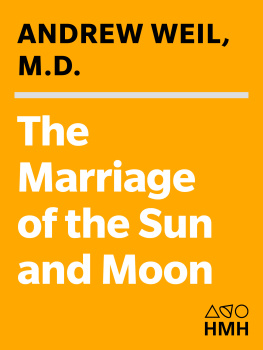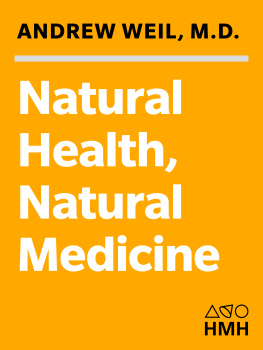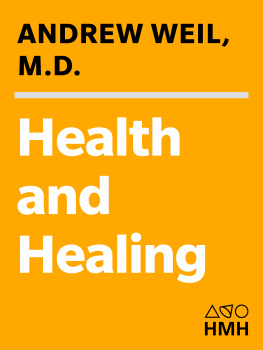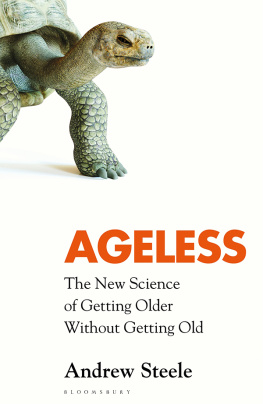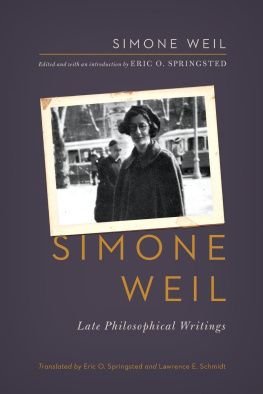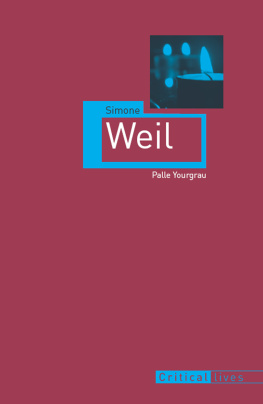Andrew Weil, M.D.
Andrew Weil, M.D., a graduate of Harvard College and Harvard Medical School, is Clinical Professor of Medicine at the University of Arizona and director of the Program in Integrative Medicine at that institution. He is also the founder of the Foundation for Integrative Medicine in Tucson, Arizona, and editorial director of the www.drweil.com. He is the author of numerous books and lives in Tucson.
B OOKS BY A NDREW W EIL , M.D.
Eight Weeks to Optimum Health: A Proven Program for Taking Full Advantage of Your Bodys Natural Healing Power
Spontaneous Healing: How to Discover and Enhance Your Bodys Natural Ability to Maintain and Heal Itself
Natural Health, Natural Medicine: A Comprehensive Manual for Wellness and Self-Care
Health and Healing
From Chocolate to Morphine: Everything You Need to Know About Mind-Altering Drugs (with Winifred Rosen)
The Marriage of the Sun and Moon: A Quest for Unity in Consciousness
The Natural Mind: A New Way of Looking at Drugs and the Higher Consciousness
The Healthy Kitchen: Recipes for a Better Body, Life, and Spirit (with Rosie Daley)
Healthy Aging: A Lifelong Guide to Your Well-Being
Why Our Health Matters: A Vision of Medicine That Can Transform Our Future
Spontaneous Happiness: A New Path to Emotional Well-Being
True Food: Seasonal, Sustainable, Simple, Pure (with Sam Fox and Michael Stebner)
Fast Food, Good Food: More Than 150 Quick and Easy Ways to Put Healthy, Delicious Food on the Table
Why We Age
from Healthy Aging
by Andrew Weil, M.D.
A Vintage Short
Vintage Books
A Division of Penguin Random House LLC
New York
Copyright 2005 by Andrew Weil
All rights reserved. Published in the United States by Vintage Books, a division of Penguin Random House LLC, New York, and in Canada by Random House of Canada, a division of Penguin Random House Canada Limited, Toronto. Originally published in hardcover as part of Healthy Aging in the United States by Alfred A. Knopf, a division of Penguin Random House LLC, New York, in 2005.
Vintage and colophon are registered trademarks of Penguin Random House LLC.
The Cataloging-in-Publication Data for Healthy Aging is available from the Library of Congress.
Vintage eShort ISBN9780525435037
Cover design by Perry De La Vega
www.vintagebooks.com
v4.1
a
Contents
Aging is a deteriorative process, as most people should know.The fact is that everything will [age], whatever the hell you do. Everything in the universe ages.
Leonard Hayflick
There are many theories as to why we age. Some focus on the accumulation of errors in the genetic code, others invoke loss of telomeres. You dont need to know the details of all of these theories, but I thought it might be interesting to review two of them to give you a sense of the ways researchers are thinking. The first has to do with a chemical process called caramelization, and the second concerns oxidative stress. Both have practical import, the former because it suggests that dietary changes may reduce the risks of age-related diseases, the latter because it raises questions about whether we should take antioxidant vitamins and minerals in order to preserve youthful health and function as long as possible. Both theories suggest that senescence and longevity are separable, that age-related disease is not a necessary consequence of aging.
If you heat sugar in a pan, it first melts and then, when it reaches 170C (338F), it begins to turn brown, a change that happens faster in the presence of an acid catalyst, like a bit of lemon juice or vinegar. This process is called caramelization and is known to all experienced cooks. Although it looks simple, the chemical change, which involves the internal rearrangement of sugar molecules, is so complex that it is not fully understood. To give you just a hint of that complexity, let me share a section of a technical paper:
Caramelization occurs in a sequence of six steps: The initial enolization reaction is of particular importance because it initiates the subsequent chain of events. These reactions give rise to aliphatic sugar degradation products which can react further to produce oxygen heterocyclic and carbocyclic compounds via aldol condensation.
I hope you will not be disappointed if I omit steps two through six.
Cooks need not understand the chemistry of caramelization in order to take advantage of it. They use a related process when they boil mixtures of sugar, cream, corn syrup, and butter to make caramel candy. In this case, the brown color and flavors result from a reaction between the sugars and the protein molecules in the cream and butter. It is called the Maillard reaction, after Louis-Camille Maillard, the French scientist who first described it in 1912. Also called the browning reaction, this interaction of proteins and sugars is the basis of many appealing recipes. It is why roasts brown in the oven, why french frying turns potatoes crispy and tasty, why toast toasts, and why baked lasagna develops a delicious, chewy, golden-brown crust.
As with the caramelization of sugars, details of Maillard reactions are dauntingly complex, even for chemists. What is clear is that these chemical interactions not only explain the appearance, aroma, and flavor of many favorite foods but also account for a great many other phenomena, from the yellowing of old photographs made with egg-white emulsions to the brown color of soil (from combinations of sugars and proteins in decaying organic matter). Maillard had a sense of the vast reach of his discovery when he wrote in his original paper, The implications of these facts seem to me as numerous as they are interesting in many branches of science. He specified human pathology as one of those branches.
Both the browning reaction and caramelization occur normally in living systems. They do not require the heat of an oven or saucepan; body temperature is perfectly conducive to them if chemical catalysts are present. Our bodies are full of sugars, proteins, and plenty of catalysts. Some bodies have more sugar circulating around them than others. Diabetics, especially, have intermittently high levels of blood sugar (glucose) when there is not enough insulin (or receptors for it) to facilitate sugar transport into cells. Doctors have long observed accelerated development of a number of age-related diseases in people with diabetes, including cataracts and atherosclerosis. They also recognize that much of this pathology is the result of chemical reactions between glucose and proteins, a process called glycation that is nothing other than a Maillard reaction.
Think for a moment about caramel candy and that top layer of baked lasagna. Products of Maillard reactions tend to be brown and sticky. Glycation and related chemical reactions produce, for lack of a better word, gunk, and gunk gums up the works. Might aging be the result of the slow browning and caramelization of our tissues?
Dr. Anthony Cerami, a medical researcher and inventor and member of the National Academy of Sciences, advanced just such a glycation theory of aging in 1985. It postulates that reactions between proteins and sugars in the body eventually form a class of compounds called advanced glycation end products, or AGEs for short. AGEs can damage other proteins as well as DNA and RNA. They do so by fostering abnormal bonds between adjacent protein strands, a change called cross-linking. Cross-linked proteins are deformedless elastic, less flexible, and less able to perform their normal functions. It is cross-linking that makes the proteins in the lens of the eye turn opaque to form a cataract. Cross-linked proteins account for the wrinkling and sagging of old skin. Cross-linked proteins in blood vessels are the basis of arteriosclerosis, hardening of the arteries. Cross-linked proteins in the brain may contribute to the development of neurogenerative diseases like ALS, Parkinsons, and Alzheimers.


